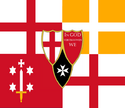Sotirian Commonwealth
Sotirian Commonwealth Sotirilijk Gemenebest | |||||||||
|---|---|---|---|---|---|---|---|---|---|
| 1642-1719 | |||||||||
| Motto: In God Vertrouwen We "In God We Trust" | |||||||||
| Capital | Voorzienigheid | ||||||||
| Religion | Puritein Kasperism | ||||||||
| Government |
| ||||||||
| Stadtholder | |||||||||
• 1642 | Jan van Etten | ||||||||
| Minister-General | |||||||||
• 1642-1669 | Jan van Etten | ||||||||
• 1669-1682 | Constantijn van Daalen | ||||||||
• 1682-1693 | Adriaan Kuypers | ||||||||
• 1693-1696 | Johan de Wet | ||||||||
• 1696-1719 | Willem Jan Koenders | ||||||||
| Legislature | States-General (1642-1646) States-Spiritual (1646-1719) | ||||||||
| History | |||||||||
| 7 September 1642 | |||||||||
| 11 May 1642 | |||||||||
| 6 July 1642 | |||||||||
| 12 October 1673 | |||||||||
| 9 May 1719 | |||||||||
| 9 May 1719 | |||||||||
| Currency | Guilders | ||||||||
| |||||||||
| Today part of | |||||||||
The Sotirian Commonwealth, (Hennish: Sotirilijk Gemenebest) was a theocratic Kasperist state that governed North Hennehouwe between 1642 and 1719. It emerged out of the First Hennish Republic in wake of Van Etten’s Purge, when Puritein parliamentarians overthrew the orthodox Amendist majority.
The origins of the Commonwealth began in 1537, with the partition of the Kingdom of Hennehouwe. Embattled by sectarian strife between the Amendist north and Solarian Catholic south and loss Of its unifying King, led to the division of the country along sectarian and geographical lines. The north became an aristocratic republic, while the south retained a monarchy.
Between 1537 and 1642, the First Republic was divided between the majority orthodox Amendists and a rising faction known as the Puriteinen (lit. Puritans), who sought to rid the north of its real and perceived Catholic traditions. While, the north emerged as the more economically and militarily powerful of the two Hennish polities, its division over religion often tripped over into violence. The inability of the less religious minded mainstream Amendist MPs to confront the Puriteinens ultimately led to the infiltration of the States-General and the overthrow of the mainstream elite by the Fellowship of Saint Jacob, the most powerful Puritein body in 1642, through Van Etten’s Purge.
Within months, Jan Van Etten and his followers had dismantled the First Republic and established a theocratic system. The Commonwealth saw government by “Godly virtue”, including the banning of blood sports, non-religious activity on Sundays, the mass persecution of non-Puritein Amendists and Catholics and the expulsion of the Atudites. The Commonwealth also launched and backed colonisation of Nuvania, and sent soldiers across Euclea to aid Amendists in the Amendist Wars.
Between the 1660s and 1710s, the Commonwealth would engage in numerous wars and battles with the Catholic Duchy of Flamia to the south. These conflicts would ultimately lead to vast devastation, loss of life and the collapse of the Commonwealth in 1719, when the southern monarchy reunited Hennehouwe with aid from the Kingdom of Gaullica.
Today the legacy of the Commonwealth is found the Amendist Belt of Hennehouwe and continued division and pillarisation of Hennish society along sectarian lines. Many historians note the severity and extremist nature of the theocracy, though debate exists over the justification for the system.
Name
The official name of northern Hennehouwe is open to interpretation by historians. Documents from the time refer to the polity as a "Republic" (Republiek) and "Commonwealth" (Gemenebest). The latter is a traditional Estmerish term for a political community founded for the common good. The founding document of the state, is quoted as, "That the People of Hennehouwe and of all the Dominions and Territories thereunto belonging are and shall be and are hereby constituted, made, established, and confirmed to be a Commonwealth under God in Heaven." With many of the new regime's founding fathers having spent time in Estmere, many historians argue that the term was imported under the same meaning. As such, many historians regard the official title as Commonwealth. However, documents interchange between Commonwealth and Republic freely.
History
Origins
Van Etten's Purge
Establishment of theocracy
Prosperity and colonisation
Hennish Wars
Collapse
Government
Prior to Van Etten’s Purge, many within the Puritein Movement and especially, the Fellowship of Saint Jacob, rarely produced documents or arguments on government other than the need for “Godly and Virtuous Rule.” As such, when the Fellowship seized power in 1642, for several weeks it maintained the aristocratic parliamentary system through the States-General.

